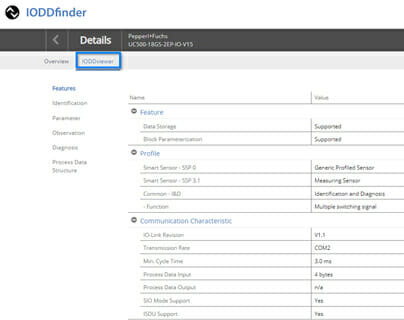IODDviewer – The next step in the evolution of IODDfinder
IODDfinder, an essential tool established by the IO-Link Community for providing IODDs (device descriptions for IO-Link devices) has become highly recognized and much used in recent years. This recognition and use are not only reflected by the sheer number of device descriptions and amount of support for devices available in the database, but by the level of active utilization by users as well.
Currently, this central database contains IODDs from more than 100 manufacturers with support for well over 20,000 IO-Link devices. In 2020 alone, the number of IO-Link devices represented in IODDfinder rose by around 70%. Increasing acceptance and use are also confirmed by the download statistics, with well over 600,000 recorded monthly downloads and rising. These downloads almost always occur automatically, i. e. directly from user tools or applications.
IODDfinder enhanced with a new feature: IODDviewer
The success of IODDfinder has motivated the IO-Link Community to make available to users an additional benefit of this kind of central database: a new function called IODDviewer.

IODDviewer menu and display of parameters
IODDviewer models three levels of information:
- An overview of supported IO-Link features, profiles and communication properties
- A depiction of the user interface described in the IODD with all parameters and their value ranges
- A detailed view with technical information on individual parameters and data types/structure
What this means for the user in concrete terms is that IODDs now no longer need to be downloaded and possibly installed in order to get an overview of a device function. Just as in an IO-Link tool, an IODD view is now available directly in the browser window through quick access in IODDviewer. This rather technical view of parameter details now also serves as, among other things, a central reference guide on specific IO-Link parameters, e.g. for software development.
In the first step, IODDviewer only supports the display of IODDs for IO-Link devices according to specification 1.1. This accounts for more than 90% of all IO-Link devices today. In a subsequent step already in development, all IODDs and other features will then be displayed.
The advantages of IODDviewer to the user are clear: Information on devices and their IO-Link properties and functions can be called up from a central location with a standardized user interface and can be displayed without any additional tools.








